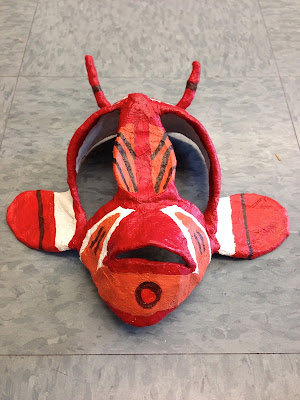I love Thanksgiving, so I'm celebrating with a preview. It's upside down, but I can't show what it's really going to look like yet.
HAPPY THANKSGIVING!!!
Thursday, November 24, 2016
Wednesday, November 23, 2016
Process for Student 2 Painting
He's not especially happy that I picked pinks and purples for his skin tone, but I like to use arbitrary colors in my paintings.
Tuesday, November 22, 2016
Painting of Student 1
I did my students' assignment with them last year. This student was not in my class, but he asked me to paint him.
Medium: Acrylic paint on canvas paper
Title: David
Date: May 2016
Medium: Acrylic paint on canvas paper
Title: David
Date: May 2016
Monday, November 21, 2016
Digital Self-Portrait
I have done this type of artwork a couple of other times for Illustration Friday topics. (Oct. 29, 2008, March 21, 2008, and March 31, 2008)
I decided to resurrect this assignment for my students, and therefore practice it myself. I think I need to add some shading underneath my body yet, so maybe I'll be fixing it and reposting later.
Thursday, April 07, 2016
Tuesday, March 29, 2016
Sample Stop-Motion Animation Unit Plan
Stop Motion Animation UNIT LESSON PLAN
| ||||
TEACHER: S. Wieringa
|
TIME: 48 minute class periods
|
DATE: 2 ½ Weeks
| ||
SUBJECT:ART/Video/
Technology
|
Stop Motion Animation
| |||
STANDARDS
|
New York State Visual Art Standards: 1 and 2
|
National Visual Art Standards:
Creating: 1, 2, 3
Presenting/Producing: 5, 6
Responding: 9
| ||
Common Core Writing Standards:
W3—Write narratives or real or imagined experiences
W4—Produce clear and coherent writing
W5—Plan, revise, rewrite, and edit writing
W6—Use technology to produce and publish writing
| ||||
OBJECTIVE
|
SWBAT: create a narrative using a series of still images (photographs)
SWBAT: imply the direction and speed of movement by taking still photographs of objects after moving them a little or a lot
SWBAT: create a coherent sequence of actions by placing images in order in video-editing software
| |||
TOOLS/Materials
|
• Point and Shoot cameras, DSLR cameras, or cell phone cameras (one for each person if doing individual student videos, or one for each group if collaborative work is happening)
• Tri-pods/stands/selfie-sticks (one for each group/camera/phone)
• Various art supplies for setting/background (large paper, cardboard, fabric, posters, photos etc.)
• Toys, inanimate objects, stuffed animals, action figures, etc. for characters in the narrative
• Computers with video editing software (Windows Moviemaker, iMovie, WeVideo, Adobe Premiere or the like)
| |||
PROCEDURES
|
Day 1: Introduction to Narrative and storytelling: Class discussion and teacher directed notes about the elements of narratives: Setting, characters, hook, plot, rising action, climax, resolution. Watching a couple of animated shorts on YouTube to see the storytelling elements in action—quick class discussion after each.
Day 2: Introduction to techniques: Watching “How-To” videos about creating various kinds of stop-motion animation. Teacher directed instruction about options of materialsand supplies to use for setting, characters, props.
Day 3: Planning day: This is the day to divide students into groups if the videos are going to be collaborative. Student brainstorming, mind-mapping, sketching around themes, images, sequence, and characters involved in the story/action. Write narrative. Exit Ticket: Group proposal with choices they have made for video and outline.
Day 4: Homework due (optional see below) Planning/Set Up: Students will finish planning the story and sequences. Students will set-up or create a backdrop or setting for their scenes. Students can start taking photographs if they are ready.
Day 5: Work day: Students will begin class by setting up their scene and their cameras on their tripod. Students will take a photograph move their character, take another photograph, and keep going until there are a sequence of photographs that imply linear/chronological movement.
Day 6: Progress sharing around the circle: Student groups will share their themes, story arcs, and progress so far. Class mates will ask clarifying questions and give feedback in terms of strengths and challenges—With any extra time in class student groups can continue taking photos
Day 7: Work day: Students will begin class by setting up their scene and their cameras on their tripod. Students will take a photograph move their character, take another photograph, and keep going until there are a sequence of photographs that imply linear/chronological movement.
Day 8: Revising, and Editing: Students will upload their photos to the computer and put them in the correct sequence in the video editing program. Students will then adjust the timing of the clips to be less than a second in order to create the movement (some clips can be a bit longer than others to create necessary pauses for the eye.)
Day 9: Revising, Editing and Adding finishing touches: Students will finish editing, add music* if needed, and add titles and credits. (*Music that has a Creative Commons—No Derivatives license or music in the Public Domain are the only songs that are legal to add to videos)
Day 10: Peer Group Feedback and Final Editing: Groups will pair up and show their videos to each other as is. The peer group will give suggestions for fixes and finishing as professionally as possible. Groups will go back to their own videos to fix anything and finish them off. Students will fill out self-assessment for their video (craftsmanship, creativity, theme, story-telling characteristics)
Day 11-Day13: (How many days this takes depends on how many students there are in class, how many videos there are to share, and how long the videos end up being.) Viewing: Make some popcorn (if you are allowed at your school) and have a Short Stop-Motion Animation Film Festival! (I like to have the students’ self-assessments in front of me while I watch the videos to help me grade them.)
| |||
ASSESSMENT
|
Formative:
Student proposals (Day 3)
Round-table sharing of progress (Day 6)
Summative:
Student self-assessment (craftsmanship, creativity, theme, story-telling characteristics) (Day 10)
Teacher assessment (Days 11-13)
| |||
HOMEWORK
|
Students can bring in any objects they want to use for their characters (toys, inanimate objects, stuffed animals, action figures, etc.)
| |||
4 KEYS for LEARNING
| ||||
_X_ Public Performance (Sharing progress along the way and giving peers feedback)
_X_ Self Study (self-assessment)
_X_ Other Study (step-by-step how to make a stop-motion animation video)
_X_ Community that Supports and Challenges (Feedback for peers)
| ||||
Thursday, March 17, 2016
Video as Artform; Video as Research Tool
I presented at the NAEA Convention in Chicago this year!
The purpose of this presentation is to share various animation and video-making techniques that serve to engage the secondary student in using video as an art form and using video to share research on arts related topics. I will share ideas about designing lessons and curricula, and I will also present student videos to show how students have been engaged in the process. Tools used to create movies with students can be as simple as cell phone pictures and videos, and Windows Movie Maker or iMovie, or as complex as HD video cameras, digital SLR cameras, and Final Cut Pro depending on school resources and technology. Click here to see pdf of the handout below.
Wednesday, March 16, 2016
Friday, January 29, 2016
I've Been Thinking...
Lately I've been thinking about working alongside students more and planning for them and grading less. I want to inspire and be inspired. I think that the start of the new semester on Tuesday will set me up for that. How will I begin to inspire students to be creative when they don't know how to be so, and work when they don't know what to do next?
I can't stop thinking about listening to Phil Hansen speak at the NAEA Convention in 2014 (I think.)
Here's an article about creativity within constraints
Phil Hansen's Ted Talk
Phil Hansen's Goodbye Art Academy
Phil Hansen's artwork
I can't stop thinking about listening to Phil Hansen speak at the NAEA Convention in 2014 (I think.)
Here's an article about creativity within constraints
Phil Hansen's Ted Talk
Phil Hansen's Goodbye Art Academy
Phil Hansen's artwork
Thursday, January 14, 2016
Basket Weaving: Upcycle Saucer Basket
This is the first time I have ever made a basket. I taught myself from Blick's lesson plan and the related video.
It was such a therapeutic process. Over, under, over under, over, under, over, under...If you are stressed I highly suggest doing a bit of weaving.
It was such a therapeutic process. Over, under, over under, over, under, over, under...If you are stressed I highly suggest doing a bit of weaving.
I couldn't figure out how to sew the lip of the basket, so I put the waxed thread around it and put wood glue all around the top. That baby is not coming apart.
Wednesday, January 13, 2016
Subscribe to:
Posts (Atom)

























